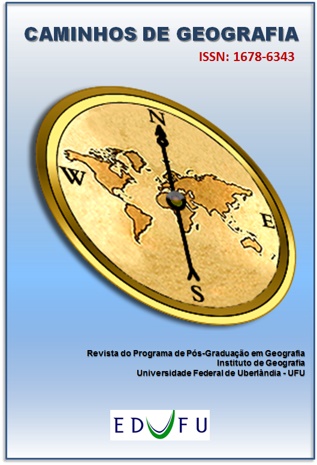MAPPING RISK AREAS TO FLOODS USING GIS ENVIRONMENTAL GEOTECHNOLOGIES: CASE STUDY OF THE RIBEIRÃO CALADÃO HYDROGRAPHIC BASIN - CORONEL FABRICIANO/MG
DOI:
https://doi.org/10.14393/RCG238658450Keywords:
Physiographic characteristics, Geographic Information System, Susceptibility, Vulnerability, RiskAbstract
The Ribeirão Caladão Hydrographic Basin (BHRC),located in the municipality of Coronel Fabriciano / MG,has passed since the 1960an accelerated disorderly occupation that, associated with the peculiar natural conditions, form a framework of physiographic and anthropic conditions that result in areas at risk of flooding. Given this fact, the objective was to identify and classify the areasat risk of flooding in BHRC using the software TerraViewHidro 0.4.5 and ArcGIS10.8, using the algebra technique of maps to elaborate the models ofsusceptibility and vulnerability delimited by the model HAND (Height Above Nearest Drainage), resulting in the flood risk model. The results showed that 53.03% of the areas susceptible to flooding are considered at risk and are located in all sub-basins of BHRC, with sub-basins III and V concentrating the majority of the population in areas of high degree of risk. The present research culminated in a flood risk letter that characterize the phenomenon and the vulnerability conditions of BHRC, based on an effective and lowcost method that can be applied in other Brazilian municipalities.
Downloads
Downloads
Published
How to Cite
Issue
Section
License
Copyright (c) 2022 Vlamir Soares Fonseca, Daniel Brasil Ferreira Pinto, Caio Mário Leal Ferraz, Ivan Carlos Carreiro Almeida, Alexandre Faissal Brito

This work is licensed under a Creative Commons Attribution-NonCommercial-NoDerivatives 4.0 International License.
Autores que publicam nesta revista concordam com os seguintes termos: a) Autores mantém os direitos autorais e concedem à revista o direito de primeira publicação, com o trabalho licenciado sob a Creative Commons Atribuição-NãoComercial-SemDerivações 4.0 Internacional. b) Autores têm permissão e são estimulados a publicar e distribuir seu trabalho online (ex.: em repositórios institucionais ou na sua página pessoal), já que isso pode gerar alterações produtivas, bem como aumentar o impacto e a citação do trabalho publicado. c) Em virtude de aparecerem nesta revista de acesso público, os artigos são de uso gratuito, com atribuições próprias, em aplicações educacionais e não-comerciais.











